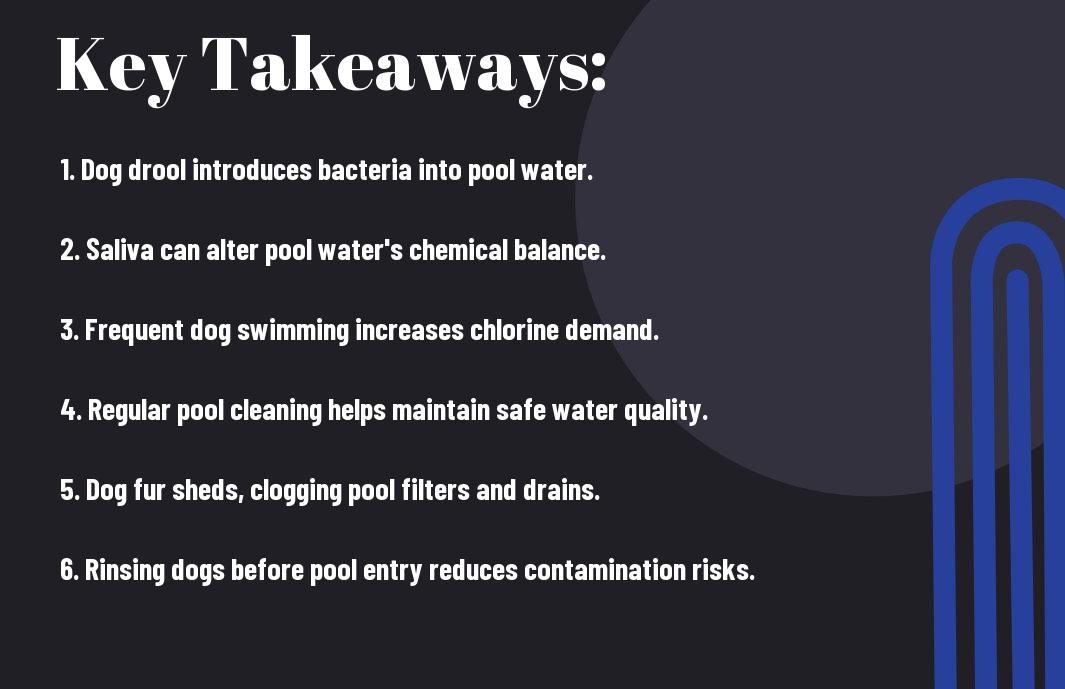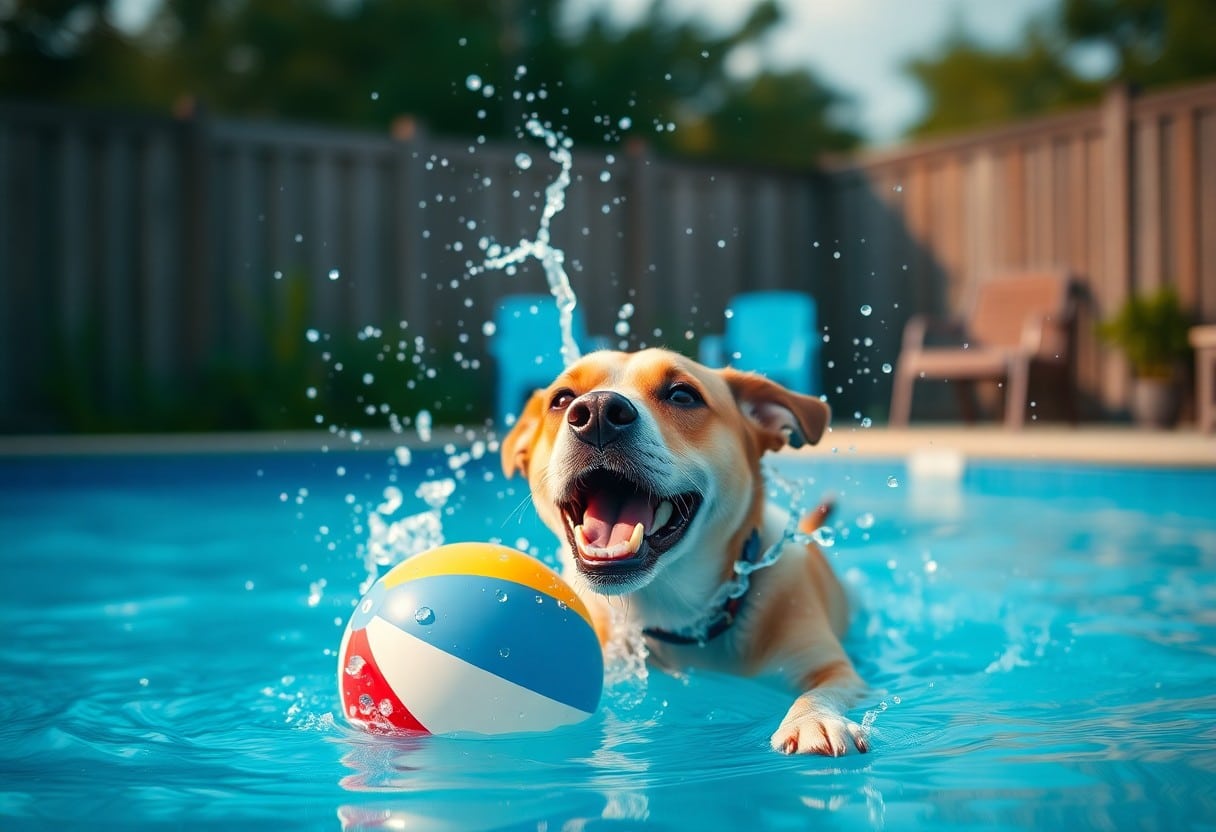With warm weather enticing you and your canine companions to take a refreshing dip, you may not realize how your furry friends impact your pool water. Dog saliva and pet dander can introduce bacteria and disrupt chemical balance, affecting water clarity and hygiene. In this post, we’ll explore the various ways your dog influences pool conditions, plus tips to keep your swimming spot clean and safe for everyone. Understanding these effects will not only enhance your swimming experience but also ensure a healthier pool environment for both you and your pets.
The Unseen Impact of Dogs on Pool Water Quality
Every time your dog takes a leap into the pool, they’re not just making a splash; they’re introducing a range of potential contaminants that affect water quality. From fur to saliva, dogs can significantly alter the chemical makeup and cleanliness of your pool. These unseen impacts can influence everything from chlorine demand to overall sanitation, leaving pool owners grappling with water that requires more maintenance to keep it sparkling and safe.
How Dog Attributes Influence Pool Cleanliness
Different breeds present distinct challenges when it comes to maintaining pool hygiene. Dogs with long, thick fur may shed more, contributing to increased debris in the water, while smaller, hairless breeds might carry oils and other compounds that alter the water’s chemistry. Knowing your dog’s coat type and hygiene habits can help you gauge how much extra effort you’ll need to put into cleaning your pool regularly.
The Chemistry of Canine Contaminants
Dog saliva, urine, and fur introduce organic compounds that can disrupt pool chemistry. Saliva may contain bacteria and enzymes that can affect pH and chlorine levels, while urine can introduce nitrogen and phosphorus, leading to algae overgrowth. These contaminants can create an imbalanced environment that not only requires more frequent chemical adjustments but may also pose health risks for both humans and pets.
When dogs enter the pool, their saliva can release specific enzymes that interfere with chlorine’s effectiveness, often resulting in a higher demand for this crucial sanitizer to maintain safe water. Additionally, the nitrogen compounds found in dog urine contribute to elevated levels of ammonia. This interaction can create an imbalance, leading to cloudy water and even unpleasant odors. Regular monitoring of water chemistry becomes necessary to counteract these impacts and ensure a safe swimming environment for everyone involved.


Recognizing Canine Contributions to Pool Pollution
Your furry friend’s fun in the pool comes at a cost—namely, contaminants that can degrade water quality. As dogs swim, they inadvertently introduce saliva, fur, and dander, all of which can lead to unwanted pollutants in your pool. This combination not only affects the pool’s aesthetics but also poses potential health risks for both humans and pets. Understanding these contributions is key to maintaining a clean, safe swimming environment.
Identifying Common Contaminants
Through swimming and playing, dogs can introduce a variety of contaminants into your pool, including fur, saliva, and skin cells. Additionally, if your dog has been romping around outside, they may bring along dirt, pollen, and other organic matter, contributing to algae growth and other water quality issues. These elements can create a breeding ground for bacteria and alter your pool chemistry, necessitating thorough cleaning and maintenance.
Understanding Water Testing for Dog Contributions
Water testing offers a practical solution to assess the impact of your canine companions on pool quality. Utilizing simple test kits, you can measure levels of chlorine, pH, and other critical factors to determine how your dog’s presence affects the water chemistry. Regular testing can reveal fluctuations linked to your dog’s swimming habits, guiding you in making adjustments to keep your pool in optimal condition.
Evaluating pool water using testing kits is straightforward and provides vital insights into how your dog influences the overall cleanliness. Many tests focus on parameters like total chlorine levels and pH balance, which can shift due to organic matter introduced by your pet. For instance, elevated ammonia levels may signal an increase in dog-related contaminants, indicating a need for additional sanitation measures such as shock treatments or enhanced filtration. A proactive approach to testing ensures you maintain a healthy environment for both you and your furry friends.

Practical Steps for Cleaner Pool Water
Keeping your pool water pristine while accommodating your furry friend calls for some targeted strategies. With a few mindful practices, you can mitigate the effects of dog hair, dirt, and bacteria on your beloved oasis, ensuring a safe and inviting environment for both you and your pet.
Essential Pool Maintenance Tips for Dog Owners
As a dog owner, maintaining pool water quality can be a bit of a balancing act. Regularly skim the surface for dog hair and debris, vacuum the pool to eliminate settled particles, and monitor chemical levels frequently to address any fluctuations caused by your canine’s presence. Consider these tips:
- Brush your dog before swimming sessions.
- Bath your dog after pool time to reduce contaminants.
- User a high-quality pool filter designed for pet owners.
- Maintain proper chlorine levels regularly.
Perceiving these maintenance habits as a routine will help keep your pool inviting.
Best Practices for Minimizing Canine Contamination
Creating a clean swimming environment for your dog and yourself often requires a few strategic adjustments. Establishing designated areas for your dog to rinse off before jumping into the pool is a significant first step. Using a dog ramp or steps can reduce splashes and spills, while also making it easier for your dog to exit without muddying the surroundings. Providing your pet with a dedicated water source outside the pool will minimize their inclination to drink pool water, thus reducing contamination. Also, consider using a dog-friendly pool cover that can help keep debris and hair at bay when the pool is not in use, leading to a cleaner experience overall.
A Dog-Friendly Pool Experience
Creating a dog-friendly pool environment elevates summer fun for both you and your four-legged companion. Emphasizing safety and comfort, you can implement features such as shallow areas for easy access and ramps for older or less agile dogs. Additionally, providing shaded spots around the pool allows dogs to cool off without getting overheated, ensuring a safe and enjoyable swimming experience for everyone involved.
Designing Your Pool Area for Canine Access
To enhance your dog’s pool experience, consider incorporating non-slip surfaces around the pool’s edge. Smooth surfaces can lead to slips and falls, so textures like rubber matting or textured tiles can provide better footing. Include easily accessible entry points with graduated steps or doggy ramps that facilitate safe entry and exit, making it easy for your pup to jump in and out at their leisure.
Fun Activities to Keep Dogs Safe and Clean
Engaging in poolside activities can enhance your dog’s fun while also ensuring they stay safe and clean. Plan games like fetch, where you can throw a floating toy into the pool, encouraging your dog to swim and retrieve it. Additionally, scheduling regular rinses after swimming minimizes chlorine absorption and keeps their coat healthy. Baths using dog-specific shampoos post-swim not only remove pool chemicals but also help maintain their skin’s natural oils.
Incorporating interactive toys, such as water-friendly fetch sticks or floating balls, can keep your dog entertained for hours while swimming. As dogs swim, they often shake off excess water – that’s why having an outdoor mat or towels readily available is wise to help dry them off. This simple routine, combined with playful water games, creates a conducive and enjoyable pool environment while mitigating the chemical load in your pool water from their presence.
The Role of Dog Behavior in Pool Hygiene
Your dog’s behavior plays a significant role in maintaining pool hygiene. Excessive splashing, fetching items from the water, and even jumping in without permission can stir up debris and increase contaminants. Understanding how your pooch interacts with the water is vital for keeping the pool clean and safe for swimming. Simple adjustments, such as establishing boundaries or routines, can minimize the impact your dog has on the water quality, allowing you both to enjoy a refreshing swim without worry.
Training Techniques for Poolside Manners
Implementing positive reinforcement techniques can shape your dog’s poolside behavior effectively. Teaching commands such as “stay” or “wait” can prevent your pup from jumping into the water at inopportune times or tracking dirt onto the deck. Incorporating a designated entry point for your dog will also streamline their interactions with the pool, keeping your water cleaner. Regular practice and rewarding desired behaviors help your dog associate pool rules with positive experiences, enhancing both safety and hygiene.
Recognizing Signs of Stress or Discomfort in Dogs
Assessing your dog’s emotional state while around the pool is key to ensuring their well-being. Behavioral signs of stress may include excessive barking, drooling, or cowering away from the pool area. Observing these indicators can alert you to potential issues, allowing for timely intervention to keep your canine companion comfortable and happy.
Many dogs show subtle signs of stress that you might overlook. For example, panting, pacing, or avoiding eye contact often signal discomfort, particularly in a new or overwhelming environment like a pool. If your dog appears anxious, try to create a calming atmosphere by introducing them slowly to the water, using positive reinforcements, or offering a familiar toy to ease their worries. Recognizing these behaviors not only safeguards your dog’s emotional health but also enhances their overall poolside experience.
Summing up
Following this, it’s clear that your dog’s swimming habits can significantly impact your pool water quality. From shedding fur and debris to introducing bacteria, their presence requires you to be proactive in maintaining hygiene. Regular cleaning, filtration adjustments, and water testing can help you ensure a safe and enjoyable swim for both you and your furry friend. By understanding how your dog affects your pool, you can enjoy the best of both worlds while keeping your water clean and healthy.
